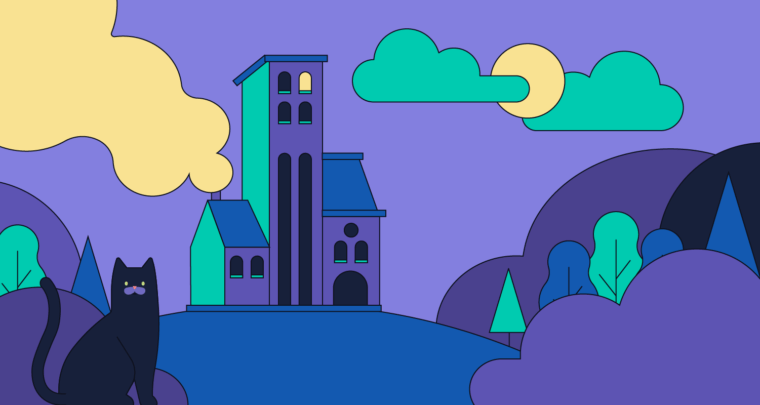
Sometimes it’s fun to be frightened. A scary story can get us out of our routine thoughts and tasks and send us into the unknown—full of omens, strange characters, and dark magic. Horror stories guarantee that something bad will happen; we just don’t know when or how until it’s too late to turn back. If you’re someone who likes getting a shiver down the spine, and you’ve got a scary story you want to share with others, maybe it’s time for you to write your own terrifying narrative.
Writing a horror story isn’t for the faint of heart: You’ll need lots of imagination, a measure of research and planning, and some clever plot twists to keep the story moving. Here, we’ll go over everything you need to know to write a bone-chilling story that will keep your readers riveted until the end.
Do you like scary stories?
Horror literature can sometimes be seen as “less than” when compared to other genres. People might consider it gimmicky or lowbrow. If this is how you view scary stories, scratch your writing itch elsewhere. Writing a good horror story isn’t easy, and horror fans are as discerning as any reader and will detect if the writing is insincere.
And consider this: Even Charles Dickens wrote ghost stories, and much of William Shakespeare’s oeuvre can be considered horror. Shirley Jackson, the author of “The Lottery,” spent her entire career writing horror stories.
Your writing can be as artful as it is terrifying.
What scares you?
Where should you begin? Dig deep into your own subconscious and consider what frightens you personally. If ghosts don’t scare you, maybe the thought of a serial killer sneaking in your window gives you the shivers. If so, write about that, no matter how uncomfortable it makes you. That squirmy feeling is exactly the position you want to put your reader in.
Just like you shouldn’t choose to write in the horror genre for cynical reasons, you shouldn’t choose the subject of your story based on current trends. Ghosts, for example, may be popular now, but if ghosts don’t scare you, that’ll come through in the writing. But if your personal fears happen to be on trend, so much the better.
It’s your personal style, your subtext, your heart, and your soul that make your writing stand out from the crowd. If you’re afraid of zombies, consider why that is. Is it because of their grotesque, rotting bodies? The loss of self? Being alone against a horde? Be as specific as possible, and your horror story will be as unique as you are.
Who should you put in your story?
Once you’ve come up with your terrifying situation, it’s time to consider who you’re going to put into this horrifying story. As with a lot of stories, your protagonist should be the last person who’d be willing to get involved.
Jonathan Harker is a straitlaced British businessman who is not at all prepared for the wild mysticism of Transylvania in Bram Stoker’s Dracula. And Father Karras isn’t sure he believes in God anymore when he’s called to exorcize a little girl in The Exorcist. Or consider how Shirley Jackson developed the story for The Haunting of Hill House after reading a study by paranormal researchers: “The story that kept coming through their dry reports was not at all the story of a haunted house, it was the story of several earnest, I believe misguided, certainly determined people, with their differing motivations and background,” she told The Guardian.
In our hypothetical ghost story, who would be the worst person to get stuck in a haunted house—someone who’s terrified of ghosts, or someone who doesn’t believe in the afterlife at all? (There’s a reason the supernatural-proof father is a trope.) It all depends on the point you’re trying to make with your story.
The character’s arc is how you demonstrate the theme. It’s the reason you’re writing anything at all. So don’t just create any bland protagonist to follow—write someone who’s going to be genuinely challenged by the horror. How are they going to grow (or not grow) when faced with this situation?
Remember, your reader comes to your story to be scared—it’s why they’re reading your horror story instead of a historical romance or a sci-fi comedy, but they stay for the characters.
Nuts and bolts of a scary story
1 Tone
Angus Fletcher, a professor at OSU’s Project Narrative, once said that audiences laugh when the Three Stooges gouge each other’s eyes out, but not when the same thing happens to Oedipus. The difference, he explained, is tone. “Tone is the writer’s version of a camera lens.”
What he means is, your tone is deciding what to show, and what not to show, your audience. Every word choice is a question of tone. It makes the reader feel scared, amused, enchanted, or disgusted.
2 Narrator
In a sense, every story has a narrator. It could be an unreliable narrator who loses their mind over the course of the plot, as with the unnamed governess in The Turn of the Screw. Or it could be a scientist coldly observing and reporting facts about the paranormal in an SCP Foundation report. But even if there isn’t an obvious narrator with a point of view, you determine how the reader experiences the story.
3 Focus
Think about what, exactly, you’re describing. The things you focus on (like a director framing her shots) tell the audience what to focus on, too. Say you’re describing the house your story is set in. Should you pay special attention to the kitchen and living room where the family gathers? Or are you going to concentrate on the dark, dank basement and musty attic? You’re the writer; it’s up to you.
4 Word choice
As you’re starting out, don’t feel the pressure to be a word stylist who constantly turns a clever phrase or writes a pithy description. Write in a way that feels natural to you, and your style will emerge on its own. One thing to note: While there are many cases when you should avoid the passive voice, sometimes it’s the best choice. The passive voice eliminates, or at least obscures, the agency of the subject. At times, that’s exactly what you want to do when writing a horror story. After all, the most terrifying thing is the unknown. “He was stabbed in the heart. His body was dragged across the floor. The crime wasn’t discovered for days.” These are perfectly cromulent sentences in a story meant to hide the killer’s, or monster’s, identity from the reader.
Writing is rewriting
Fantastic writing doesn’t simply pour out of writers’ fingertips. In fact, you’d probably be shocked at how terrible even a genius’s first draft is. This is perhaps truer of horror stories than most other writing. There is a specific effect you’re going for (as created by the tone we addressed earlier), and it can easily go wrong. There’s something intriguing about the fact that a horror story, poorly written, becomes comedic, but a poorly written comedy doesn’t become scary.
In any case, how does a writer ensure their readers gasp with terror rather than laugh with derision? Ultimately, the only way to find out is by testing it. As Stephen King puts it in his (not scary book) On Writing: A Memoir of the Craft: “Take your story through at least two drafts; the one you do with the study door closed and the one you do with it open.” In other words, your first draft should be written as fast as you can, without input from anyone whatsoever until it’s done. It may not be good, it may not even be coherent, but it’ll be pure. This raw first draft will be the material you can mold into the thrilling story you ultimately hope to create.
To produce the final product, you have to have an audience, which can include friends, significant others, your writers’ group, and family. As long as they will give you constructive and honest feedback, you’ll have something to build on. Remember that your reader is never wrong for reacting a certain way. If you don’t like their response to a scene, character, or plot point, it’s up to you to rewrite it.
Don’t overdo it
Just like some novice writers may ignore the necessity of rewriting, it’s possible to go too far in the other direction. You can get stuck in a cycle of editing and polishing until you begin to wonder why you started writing this story, or any story for that matter, in the first place!
You’ll be much better served, especially if you’re a new writer, moving on after a couple of drafts. Take another pass based on your first readers’ notes, and then share that second version with some others who can read it with fresh eyes. After that, maybe one more draft to clean it up (grammar, proofreading, spell check, etc.).
Finally, here’s a rewriting formula from King, the master of horror: 2nd draft = 1st draft – 10%.
Share your scary story
What should you do with your story now that it’s done? Share it with the world, of course! There is still a small (though not lucrative) market for short stories. Horror Tree is a wonderful resource for finding magazines and websites that publish scary stories. Of course, if you’re a horror fan, you might already know about some great horror publishers, such as LampLight, The Dark, Psuedopod, and Crystal Lake.
And in this day of social media and Web 2.0, you can always find an audience. The SCP Foundation is open to editing by anyone, and it only takes a Reddit account to reach over 16 million readers on r/nosleep.
Self-publishing, especially short stories, is also an option. Medium, Substack, and WordPress are all free and relatively easy to set up. If you market yourself and build an audience, they can all be monetized as well.
What’s stopping you?
At this point, the only thing holding you back from writing the next “Tell-Tale Heart” or “Call of Cthulhu” is your own inertia. Now that you have the tools to start writing, clear the cobwebs from your mind and start your first draft. You may be surprised at where your imagination takes you and your readers.






